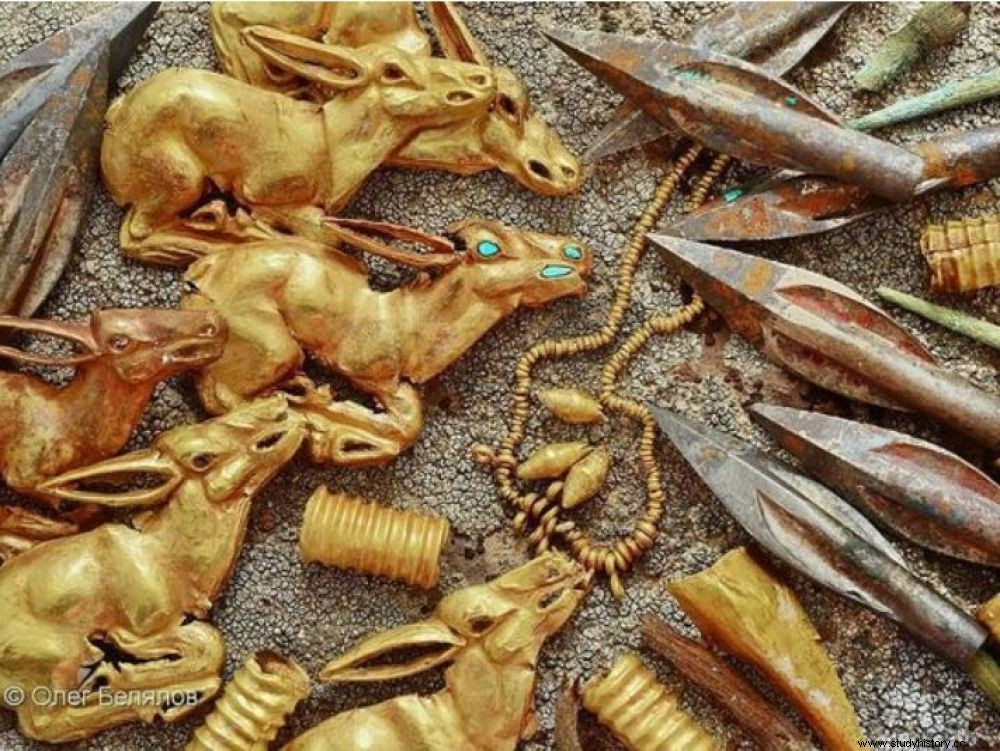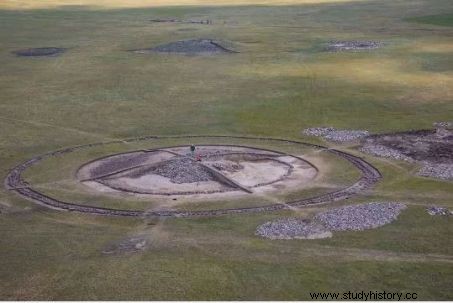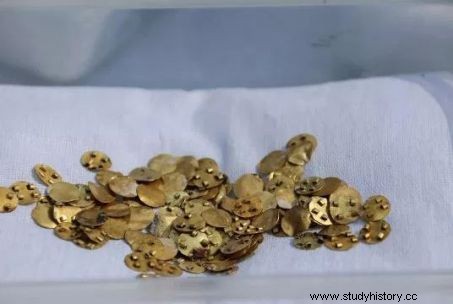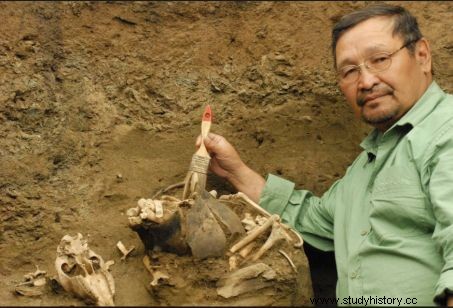A 2,800-year-old goldsmith treasure belonging to the Eastern Scythians or Sakas has been unearthed in a burial mound, east of Kazakhstan, in Central Asia.

Animals from the steppes, gold ornaments, arrowheads, more than 3000 precious objects were extracted from a kurgan belonging to the Eastern Scythians, in the northeast of Kazakhstan.
Delicate earrings, marvels with animal decorations encrusted with precious gems... The discovery of a sumptuous set of 3,000 gold ornaments was officially announced at the end of July 2018 in the distant mountains of Tarbagatai ("Massif des Marmottes ), in the northeast of the Republic of Kazakhstan. Works of the Sakas, -the name given by the Persians to the Eastern Scythians-, a vast kourgan 2,800-year-old prince, affiliated with this nomadic people of Central Asia, was unearthed by a research team led by Zainolla Samashev, director of the Margulan Institute of Archeology, in Astana, the capital of Kazakhstan. An eminent specialist in steppe cultures, the expert has been studying the Eleke Sazy plateau where these fragile treasures are extracted for several years.
The Saka Kurgan of the Tarbagatai Mountains being cleared. © Oleg Belyalov east2west news
At the heart of an imposing tumulus hidden under cairns large blocks of stone, a wooden burial chamber would still contain the remains of the occupants. As traditionally for the frozen graves of Altai, sacrificed equines are among the offerings. Several tens of meters wide, these rich Scythian mausoleums are generally located at the crossroads of an immense territory stretching from Siberia, Kazakhstan, through neighboring Mongolia and China. "To encounter such inviolate sites nowadays remains rare . Looting is common. It is from this remote region that various pieces of the famous 'Siberian' collection of Tsar Peter the Great (1672-1725) come" , says historian Yaroslav Lebedinsky, a specialist in ancient Eurasian cultures, joined by Sciences et Avenir.
Gold sequins, probably originally sewn onto clothing. © Oleg Belyalov east2west news
Called Altai Scythians, Sakas (or Saces) (read box ), the skimmer of the steppes that were these nomadic peoples were passionate about gold, weapons and horses. Their goldsmiths made admirable jewelry. Up to gold rolled into very thin sheets barely fifteen microns thick. The Scythian Sakas roamed the plains of Central Asia at the very time when the Eastern Zhou (771-256 BC) and later the Warring States (5th BC-3rd BC) were dominating the China.
Zainolla Samashev, director of the Margulan Institute of Archeology in Astana, the capital of Kazakhstan. © Margulan Institute of Archaeology.
Sakas or Asian Scythians
A group of groups related -at least by culture-, and probably by language of Iranian origin, to the Scythian branch, the Saka are a people without "history". Little information about them is indeed found in the texts of Antiquity. "We have neither a list of rulers nor historical documents. And we still don't know where to find the different tribes mentioned by the Persians" , explains Yaroslav Lebedinsky. Herodotus (5th century BC) does not say much about it. He evokes these populations sporadically, when he deals with the Persian army. "A Saka revival, however, took place at the beginning of our era, with the appearance of the Indo-Scythian kingdoms" , continues Ieroslav Lebedinsky. Saces tribes settled in northern India, creating lasting kingdoms. Eastern Scythians lasted longer than European Scythians. "Saka was still spoken in the Tarim Basin, Xinjiang (China), in the Middle Ages" , adds the historian. And it is not excluded that Iranian-speaking peoples currently living in the Pamir descend from this group.



